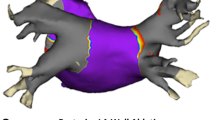Abstract
Purpose
We evaluated the correlation between pulmonary venous (PV) anatomy and acute and long-term success of PV isolation (PVI) with two balloon-based ablation catheter techniques.
Methods
One hundred consecutive patients were analyzed in two equal groups treated with either the second-generation cryoballoon (CRYO) catheter or the visually guided laser ablation (VGLA) catheter. All patients underwent multi-detector computed tomography (CT) imaging. The primary and secondary efficacy endpoints were the procedural achievement of proven electrical isolation of all veins and freedom from atrial fibrillation (AF) within a 1-year follow-up period, respectively.
Results
Variant PV anatomy was observed in 32 % of patients in the CRYO group and in 40 % of patients in the VGLA group. All PVs were targeted with either the CRYO catheter (n = 199) or the VGLA catheter (n = 206). One hundred ninety-three of 199 PVs (97 %) were successfully isolated in the CRYO group and 194 of 206 PVs (94 %) in the VGLA group (p = 0.83). Over a 12-month follow-up, AF recurrence was documented in 11/45 (24 %) and 7/43 (16 %) patients in the CRYO and the VGLA groups, respectively (p = 0.21). In the CRYO group, a larger left inferior PV size was associated with worse long-term outcome (p = 0.001). In the VGLA group, a larger left superior PV size (p = 0.003) and more oval right inferior PV were associated with worse acute success (p = 0.038). There was no absolute cutoff between PV anatomy and clinical success.
Conclusions
The variability of PV anatomy did not significantly compromise acute success of PVI or patient outcomes.



Similar content being viewed by others
References
Calkins, H., Kuck, K. H., Cappato, R., Brugada, J., Camm, A. J., Chen, S. A., et al. (2012). 2012 HRS/EHRA/ECAS expert consensus statement on catheter and surgical ablation of atrial fibrillation: recommendations for patient selection, procedural techniques, patient management and follow-up, definition, endpoints, and research trial design. Heart Rhythm, 9, 632–696.
Chun, K. R., Schmidt, B., Metzner, A., Tilz, R., Zerm, T., Koster, I., et al. (2009). The “single big cryoballoon” technique for acute pulmonary vein isolation in patients with paroxysmal atrial fibrillation: a prospective observational single centre study. European Heart Journal, 30, 699–709.
Packer, D. L., Kowal, R. C., Wheelan, K. R., Irwin, J. M., Champagne, J., Guerra, P. G., et al. (2013). Cryoballoon ablation of pulmonary veins for paroxysmal atrial fibrillation: first results of the North American Arctic Front (STOP AF) pivotal trial. Journal of the American College of Cardiology, 61, 1713–1723.
Metzner, A., Schmidt, B., Fuernkranz, A., Wissner, E., Tilz, R. R., Chun, K. R., et al. (2011). One-year clinical outcome after pulmonary vein isolation using the novel endoscopic ablation system in patients with paroxysmal atrial fibrillation. Heart Rhythm, 8, 988–993.
Dukkipati, S. R., Neuzil, P., Kautzner, J., Petru, J., Wichterle, D., Skoda, J., et al. (2012). The durability isolation using the visually guided laser balloon catheter: multicenter results of pulmonary vein remapping studies. Heart Rhythm, 9, 919–925.
Dukkipati, S. R., Kuck, K. H., Neuzil, P., Woollett, I., Kautzner, J., McElderry, H. T., et al. (2013). Pulmonary vein isolation using a visually-guided laser balloon catheter: the first 200-patient multicenter clinical experience. Circulation. Arrhythmia and Electrophysiology, 6, 467–472.
Sorgente, A., Chierchia, G. B., de Asmundis, C., Sarkozy, A., Namdar, M., Capulzini, L., et al. (2011). Pulmonary vein ostium shape and orientation as possible predictors of occlusion in patients with drug-refractory paroxysmal atrial fibrillation undergoing cryoballoon ablation. Europace, 13, 205–212.
Knecht, S., Kühne, M., Altmann, D., Ammann, P., Schaer, B., Osswald, S., et al. (2013). Anatomical predictors for acute and mid-term success of cryoballoon ablation of atrial fibrillation using the 28 mm balloon. Journal of Cardiovascular Electrophysiology, 24, 132–138.
Metzner, A., Kivelitz, D., Schmidt, B., Fuernkranz, A., Wissner, E., Tilz, R. R., et al. (2012). Impact of pulmonary vein anatomy assessed by cardiac magnetic resonance imaging on endoscopic pulmonary vein isolation in consecutive patients. Europace, 14, 474–480.
Kim, Y. H., Marom, E. M., Herndon, J. E., 2nd, & McAdams, H. P. (2005). Pulmonary vein diameter, cross-sectional area, and shape: CT analysis. Radiology, 235, 43–49.
Ahmed, J., Sohal, S., Malchano, Z. J., Holmvang, G., Ruskin, J. N., & Reddy, V. Y. (2006). Three-dimensional analysis of pulmonary venous ostial and antral anatomy: implications for balloon catheter-based pulmonary vein isolation. Journal of Cardiovascular Electrophysiology, 17, 251–255.
Marom, E. M., Herndon, J. E., Kim, Y. H., & McAdams, H. P. (2004). Variations in pulmonary venous drainage to the left atrium: implications for radiofrequency ablation. Radiology, 230, 824–829.
Bordignon, S., Chun, K. R., Gunawardene, M., Urban, V., Kulikoglu, M., Miehm, K., et al. (2013). Energy titration strategies with the endoscopic ablation system: lessons from the high-dose vs. low-dose laser ablation study. Europace, 15, 685–689.
Casado-Arroyo, R., Chierchia, G. B., Conte, G., Levinstein, M., Sieira, J., Rodriguez-Manero, M., et al. (2013). Phrenic nerve paralysis during cryoballoon ablation for atrial fibrillation: a comparison between the first- and second-generation balloon. Heart Rhythm, 10, 1318–1324.
Martins, R. P., Hamon, D., Cesari, O., Behaghel, A., Behar, N., Sellal, J. M., et al. (2014). Safety and efficacy of a second-generation cryoballoon in the ablation of paroxysmal atrial fibrillation. Heart Rhythm, 11, 386–393.
Metzner, A., Rausch, P., Lemes, C., Reissmann, B., Bardyszewski, A., Tilz, R., et al. (2014). The incidence of phrenic nerve injury during pulmonary vein isolation using the second-generation 28 mm cryoballoon. Journal of Cardiovascular Electrophysiology, 25, 466–470.
Author information
Authors and Affiliations
Corresponding author
Ethics declarations
Conflict of interest
The authors declare that they have no conflict of interest.
Rights and permissions
About this article
Cite this article
Tsyganov, A., Petru, J., Skoda, J. et al. Anatomical predictors for successful pulmonary vein isolation using balloon-based technologies in atrial fibrillation. J Interv Card Electrophysiol 44, 265–271 (2015). https://doi.org/10.1007/s10840-015-0068-3
Received:
Accepted:
Published:
Issue Date:
DOI: https://doi.org/10.1007/s10840-015-0068-3




